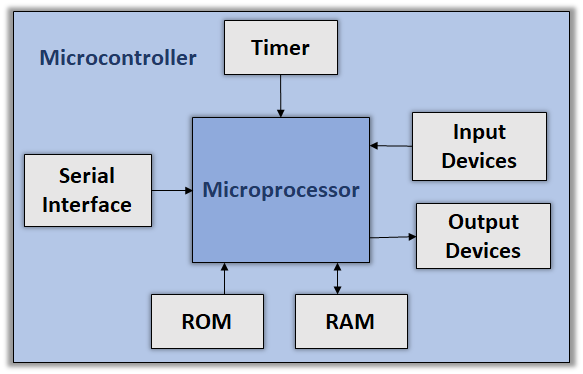Explore Upcoming Workshops Near You and Ignite Your Passion for Innovation . Reserve a Seat today!
Pre-Robotics
(Age 6-8 Years)
Robotics Course
(Age 8-10 Years)
Advanced Robotics Course
(Age 11+ Years)

Microprocessors are only made up of a CPU that is a central Processing Unit and they are used to do many complex tasks. Along with a CPU we also need many other components to complete some tasks or processes. These other parts are connected with the processor using external connections.
Microprocessors are not mainly used for specific tasks but they are mostly used for complicated and tricky tasks which require high memory and complex coding. Microprocessors are mostly used in the following devices:
scientific calculators, accounting systems, games machines, complex industrial controllers, traffic lights, defense systems, computation systems, and more.
(All the above operations are complex and they need to process the complicated data.)
Microcontrollers are designed to do a specific task or any assigned task in loops. You need some special tools to upload the program on the controller chips. Once the code is uploaded on the chip we don’t need to upload it once again on the chip unless and until we want our microcontroller to do another task.
The process is fixed in the microcontroller and the output depends on the user inputs or inputs from the sensors or fixed inputs.
Microcontrollers are mainly used in the following devices: mobile phones, automobiles, CD/DVD players, washing machines, cameras, security alarms, keyboard controllers, microwave oven, watches, and mp3 players.

In the above image, we can see the microprocessor is part of a microcontroller with extra memory RAM, ROM, input-output devices, timers, etc.
| Microprocessor | Microcontroller |
| Microprocessors are mainly used in computer systems. | Microcontrollers are mainly used in embedded systems. |
| It is just a microprocessor alone, so we need to connect memory and I/O devices externally to make it work. | The microcontroller already has memory and I/O devices connected internally with the processor. |
| It uses external connections to interface to RAM, ROM and other peripherals. | All devices are connected internally. |
| As memory, I/O devices and other peripherals are connected externally it makes the processor looks bulky. | Memory, I/O devices and other peripherals are already connected internally with the processor so the size of the circuit is comparatively small. |
| The overall cost of the system increases as we need to connect external devices with it. | The overall cost of the system is less as all devices are on a single chip. |
| We can connect external memory in ranges of megabytes and even gigabytes. But speed is less due to more memory handling. | As memory devices are present on board the speed of operations is more as compared to microprecessors. |
| Due to the bulky size, you can’t use it in a compact system. | Due to less size microcontroller is the best option to be used in compact systems. |
| The total power consumption is high for microprocessors as external devices are being used. Therefore, they are not fit to use in devices running on stored power like batteries. | The total power consumption is less for microcontrollers as all devices are present internally. So they can be used with devices running on stored power like batteries. |
| Microprocessors do not either have power-saving modes. | Most of the microcontrollers have different power-saving modes. |
| A microprocessor can do multiple tasks at the same time. | A microcontroller can only do a single task at a time. |
| Microprocessors do not have different memory modules to store programs and data. | Microcontrollers have different memory modules to store programs and data. |
| The speed of the microprocessor can be high due to higher clock speed as they are used in complex operations. | The speed of microcontroller-based systems is slow as compared to microprocessors. |
| Microprocessors can process a large number of instructions and can handle a large amount of data at a time. | Microcontrollers can process simple and less number of instructions. |
Omkar Utekar is a Project Guide at Moonpreneur. He is very keen to learn new things mostly related to robotics and coding. He is very talkative person.